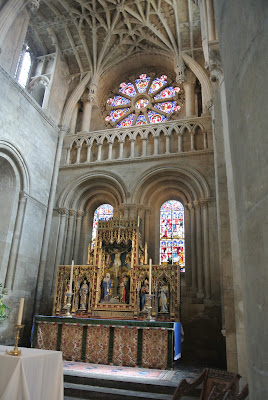Day 10, Monday 20 August
On the way to Oxford - Cirencester
Monday is market day in Cirencester – so we arrived in time to pick up some good deals at a Moroccan stall!!! The woman who ran the stall, lives in Morocco, buys her goods there and brings them back to good old England to sell them at a handy profit.
Cirencester, known as the "Capital of the Cotswolds", is an historic Roman town in the heart of the Cotswolds with attractions from a Roman Ampitheatre to the nearby Chedworth Roman Villa. We settled for a walk around the centre of the town and the market stalls before heading off to Oxford.
Oxford
The day was interesting before it had really started. We had fully intended parking the car outside Oxford and catching the bus into town. Somehow we managed to be inside the city before we knew it. So we ditched Plan A and moved directly into Plan B, park the car and walk. And walk we did not just once around Oxford but twice. You might well ask why, but that story is for another time.
First stop Christ College
Christ College is a working academic and religious institution and some areas, including the Hall and the Cathedral, sometimes close without notice. This twelfth century church is amongst the oldest buildings in Oxford, and one of the smallest Anglican cathedrals in England. It is also the only church in the world to be both a cathedral and a college chapel.
Christ College (also known as ‘The House’) was founded in 1525 by Cardinal Thomas Wolsey, and was originally called Cardinal's College. In 1546 Henry VIII took it over and renamed it Christ College. This college is the largest of all Oxford's Colleges. In the middle of the College lies Tom Quad, the largest quadrangle in Oxford; a beautiful manicured space of green lawn with welcoming signs saying – ‘keep off the grass’.
Tom Tower was dedicated to Thomas of Canterbury. The upper section of the tower was designed by Sir Christopher Wren in 1682. The 7-tonne bell in the tower chimes 101 times each night at 9:05pm, the time when the original 101 students were called back for curfew. Since Oxford is 5 minutes west of Greenwich, this is actually 9pm Oxford time.
The Great Hall (the college dining hall) was closed for the students lunch when we first visited so we came back again later and it was open and set up for the dinner session. It will look familiar to any fans of the Harry Potter films, as it inspired the set of Hogwarts dining hall. Scenes from the movie were filmed there, and on the grand stairs leading to the Hall. It is easy to imagine Harry standing up from the dinner table and making one of his very Potterish speeches in front of the witches and wizards in training at Hogwarts.
Christ College has produced 13 British Prime Ministers in the last 200 years. That's more Prime Ministers than were produced from any other college in Oxford, or by the whole of Cambridge University!
There are many other buildings worth visiting while in Oxford. Some are associated with the University, and some are not, but most of them are old and fascinating and are definitely photo-worthy. I was particularly captivated by the Bridge of Sighs. Officially known as Hertford Bridge, it is more often called the Bridge of Sighs because of the similarity to the famous bridge in Venice. It was never intended to be a replica of any existing bridge. It was completed in 1914 to connect two sections of Hertford College.
On our second lap around the city, we navigated the streets of Oxford with conviction looking for the Old Fire Station. Found it – or at least we found the spot where it used to be, which has been turned into a café. To soften our disappointment were felt justified in ordering two ice-creams.
Lower Slaughter
We decided to have another go at discovering the secrets of the much lauded Lower Slaughter. When we were there yesterday the Sunday throng made it less than appealing especially for my travelling fellow, who has an allergy to crowds.
Today Lower Slaughter ran at a much more gentle pace. The feature of LS is its row of unspoilt limestone cottages in the traditional Cotswold style, that sit beside yet another babbling brook. Trout can even be seen swimming against the flow of the brook. The stream running through the village is crossed by two small bridges and the local attraction is a converted mill with original water wheel. Gorgeousness! The name of the village of Lower Slaughter stems from the Old English name for a wet land 'slough' or 'slothre' (Old English for muddy place) upon which it lies.
It was then time to head back to Bibury. The day visitors had left and it was quiet drinks and dinner in the courtyard at the Swan Hotel on another warm English evening.








No comments:
Post a Comment